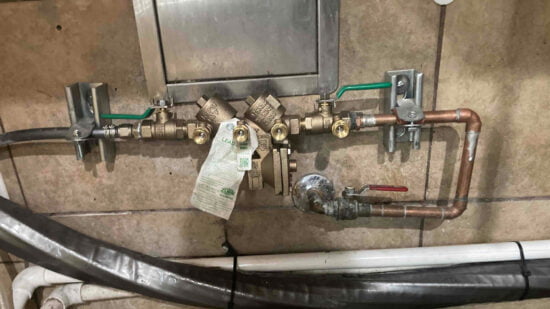Backflow is a term that many homeowners and business operators might not be familiar with, yet it’s a critical issue in plumbing that can have serious health implications. Understanding backflow and how to prevent it is essential to maintaining a safe and healthy water supply. In this article, we’ll delve into what backflow is, why it occurs, the potential risks it poses, and what professional plumbers do to prevent it.
What is Backflow?
Backflow is the undesirable reversal of the flow of water or other substances from a private plumbing system into the public water supply. This can occur in any system where there’s a cross-connection between potable (drinkable) and non-potable water sources. Essentially, backflow allows contaminants to enter the clean water supply, posing significant health risks.
Types of Backflow

There are two main types of backflow: backpressure backflow and backsiphonage backflow.
Backpressure Backflow
Backpressure occurs when the pressure in a private water system exceeds the pressure in the public water system. This can happen due to various reasons, such as a boiler system or a pump creating higher pressure in the private system. When this pressure imbalance occurs, it can force contaminants from the private system into the public water supply.
Backsiphonage Backflow
Backsiphonage is caused by negative pressure in the public water system, akin to sucking liquid through a straw. This can occur during events like water main breaks, high demand on the system (e.g., firefighting), or other situations where the pressure in the public system drops suddenly. This negative pressure can pull contaminated water from private systems into the public supply.
Why is Backflow a Problem?
The primary concern with backflow is the potential contamination of the potable water supply with harmful substances. Contaminants can include chemicals, pesticides, bacteria, and other hazardous materials. When these contaminants enter the drinking water system, they can cause a range of health problems, from mild gastrointestinal issues to severe diseases.
Common Causes of Backflow
Several scenarios can lead to backflow, including:
1. Cross-connections: Any connection between potable and non-potable water systems is a potential risk point for backflow.
2. Pressure fluctuations: Changes in water pressure, such as those caused by firefighting, water main breaks, or system repairs, can create conditions for backflow.
3. Improper plumbing installations: Incorrect installation of plumbing systems and lack of proper backflow prevention devices can contribute to the risk.
Preventing Backflow
Preventing backflow is crucial for protecting public health and ensuring the safety of the water supply. Here are some key strategies and devices used to prevent backflow:
1. Backflow Prevention Devices
There are several types of backflow prevention devices designed to stop backflow from occurring. Some of the most common include:
• Air Gap: An air gap is a physical separation between the end of a water supply outlet and the flood level of a receptacle. This is the simplest and most effective method of backflow prevention.
• Check Valves: These valves allow water to flow in only one direction, preventing backflow.
• Reduced Pressure Zone (RPZ) Assemblies: These devices provide the highest level of protection against backflow and are typically used in high-risk situations.
• Pressure Vacuum Breakers (PVBs): These are used to protect against backsiphonage and are commonly installed in irrigation systems.
2. Regular Testing and Maintenance
Regular testing and maintenance of backflow prevention devices are essential to ensure they function correctly. Local regulations often require annual testing by certified plumbing professionals to verify the effectiveness of these devices.
3. Proper Installation
Ensuring that all plumbing installations are carried out correctly and in accordance with local codes and standards is critical. This includes the installation of backflow prevention devices in all required locations.
4. Education and Awareness
Educating property owners and managers about the risks of backflow and the importance of prevention measures is vital. Awareness campaigns and informational materials can help promote understanding and compliance.
Legal Requirements and Regulations
Many regions have stringent regulations governing backflow prevention to protect public health. These regulations often mandate the installation of backflow prevention devices in certain situations, regular testing, and maintenance of these devices, and immediate action if a backflow incident occurs. Failure to comply with these regulations can result in fines and other penalties.
The Role of Professional Plumbers
Professional plumbers play a crucial role in preventing backflow. Their expertise ensures that backflow prevention devices are installed correctly, regularly tested, and properly maintained. Plumbers can also identify potential risk points in a plumbing system and recommend appropriate solutions.
Conclusion
Backflow is a significant concern in plumbing systems, with the potential to contaminate the potable water supply and pose serious health risks. Understanding the causes of backflow and implementing effective prevention measures are essential for maintaining a safe and healthy water supply. By utilizing backflow prevention devices, ensuring proper installation and maintenance, and adhering to legal requirements, we can protect our water supply from contamination. As a leading plumbing service provider, Roto-Rooter is committed to helping our customers understand and prevent backflow, ensuring the safety and integrity of their water systems.
By educating yourself on the risks and prevention methods of backflow, you can take proactive steps to protect your home or business. If you have any concerns about backflow or need assistance with backflow prevention, don’t hesitate to contact Roto-Rooter. Our team of experienced professionals is here to help you safeguard your water supply and ensure the health and safety of everyone who relies on it.